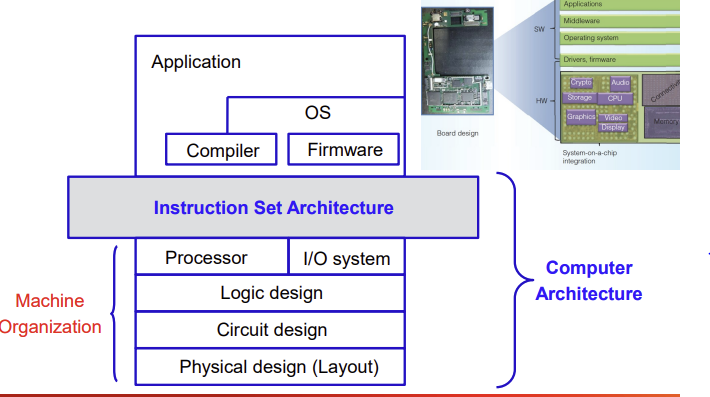목차
📕Classes of Computers
💻Personal Computers (PCs)
- 소프트 웨어의 다양성과 일반적인 목적으로 사용되는 컴퓨터
- 비용과 성능을 절충시킨 컴퓨터
- 예) desktop, laptop
💻Servers - [껐다 키는 기계가 아님]
- 네트워크를 통해서 보통 접근할 수 있다.
- 높은 공간차지, 성능, 신뢰성을 가진다.
- 소규모 서버에서 건물만 한 사이즈까지 다양한 크기를 범위로 한다.
- Low-end : 웹 서비스 혹은 작은 사업에서 사용된다.
- High-end : 슈퍼컴퓨터 혹은 데이터센터 (굉장히 많은 메모리와 프로세서, 저장공간을 가짐)
💻Embedded computers
- 시스템 내부에 탑재된 컴퓨터
- 즉 특정한 목적을 가지고 사용되는 컴퓨터.
- 일반 컴퓨터와 다르게 더 절제된 환경과 전력소비, 그리고 비용절감이 중요하다.
- 예) smartphones, tablet
📕Post-PC Era
📗PC -> PMDs(personal mobile devices)
💻PMDs
- 전력으로 작동되며, 무선으로 인터넷과 연결 가능하다.
- 키보드와 마우스가 없다.
- 예) smart phones, tablets, eletronic glasses
📗Server -> cloud computing
💻Cloud computing
- WSCs(warehouse scale computers)로 알려져 있다.
- Saas(Software as a Service)는 Cloud computing을 통해서 전개된다.
- 예) Amazon , google
📕Post-PCs의 다양성
- Wearables
- Consumer Electronics
- Smart Farming
- Automotive
- Robotics
- 3D Printing
📕컴퓨터 구조
Computer Architecture = ISA(insruction set architecture) + Machine Orgranization

📕추상화(abstraction)
우리가 기계를 사용하는데에, 세부적인 기계의 내부 구조를 알 필요가 없음.
📕컴퓨터 구조에서의 8가지 획기적인 생각.
💡Design for Moore's Law
집적 회로(IC)의 자원은 일정 주기(18~24 month)마다 2배씩 증가한다.
💡Use abstraction to simplify design
💡make the common case fast
💡Performance via parallelism
💡Performance via pipelining
💡Performance via prediction
💡Hierarchy of mermories
💡Dependability via redundancy
🔎소프트웨어의 층은 계층적 구조를 지닌다.

💻Application software
고차원적인 언어를 사용한다. ex) C, Java 등등
💻System software
Hardware와 Application 사이에 위치하고 있다.
💻Operating System(운영체제)
user's Program과 Hardware 사이에 위치한다.
- Input , Output operation (I/O)
- 메모리와 저장공간
- Resource sharing and task scheduling
- e.g) Linux, Windows, iOs
💻Compiler
고차원적인 언어로 쓰여진 프로그램을 하드웨어가 실행 가능한 명령어로 번역해준다.
💻Hardware의 구성요소
- Processor
- memory
- I/O controller
💻High-level language
- 생산성과 이식성을 제공한다.
- 컴파일러를 통해서 하드웨어가 실행가능한 명령어로 번역 된다.
💻Assembly Language
- Assemblers는 Symbolic version을 binary version으로 바꿔준다.
💻Machine Language
- binary digit(bit)로 표현된다.
- 명령어와 데이터를 encode 한다.
📕컴퓨터의 5가지 구성요소
input, output, memory, datapath, control

- Processor : datapath와 control로 이루어진다.
- 프로세서는 명령어와 데이터를 메모리로부터 읽어온다.
- Input(인풋)은 memory에다 데이터를 작성한다.
- Output(아웃풋)은 메모리로부터 데이터를 읽어온다.
- Control은 명령을 결정하는 신호를 data path, memory, input, output에다가 뿌린다.
- 모든 종류의 컴퓨터는 이러한 구성요소를 가진다.
'Computer Science > Computer Architecture' 카테고리의 다른 글
| [computer archiecture] - arithmetic_for_computers(1) (0) | 2022.10.19 |
|---|---|
| [computer architecture]-instruction_language_of_computer(3) (0) | 2022.10.11 |
| [computer architecture]-instructions_language_of_computer(2) (0) | 2022.10.09 |
| [computer architecture] - instructions- language_of_computer(1) (1) | 2022.10.08 |
| [computer architecture] -Computer Abstractions and Technology (2) (0) | 2022.09.29 |
📕Classes of Computers
💻Personal Computers (PCs)
- 소프트 웨어의 다양성과 일반적인 목적으로 사용되는 컴퓨터
- 비용과 성능을 절충시킨 컴퓨터
- 예) desktop, laptop
💻Servers - [껐다 키는 기계가 아님]
- 네트워크를 통해서 보통 접근할 수 있다.
- 높은 공간차지, 성능, 신뢰성을 가진다.
- 소규모 서버에서 건물만 한 사이즈까지 다양한 크기를 범위로 한다.
- Low-end : 웹 서비스 혹은 작은 사업에서 사용된다.
- High-end : 슈퍼컴퓨터 혹은 데이터센터 (굉장히 많은 메모리와 프로세서, 저장공간을 가짐)
💻Embedded computers
- 시스템 내부에 탑재된 컴퓨터
- 즉 특정한 목적을 가지고 사용되는 컴퓨터.
- 일반 컴퓨터와 다르게 더 절제된 환경과 전력소비, 그리고 비용절감이 중요하다.
- 예) smartphones, tablet
📕Post-PC Era
📗PC -> PMDs(personal mobile devices)
💻PMDs
- 전력으로 작동되며, 무선으로 인터넷과 연결 가능하다.
- 키보드와 마우스가 없다.
- 예) smart phones, tablets, eletronic glasses
📗Server -> cloud computing
💻Cloud computing
- WSCs(warehouse scale computers)로 알려져 있다.
- Saas(Software as a Service)는 Cloud computing을 통해서 전개된다.
- 예) Amazon , google
📕Post-PCs의 다양성
- Wearables
- Consumer Electronics
- Smart Farming
- Automotive
- Robotics
- 3D Printing
📕컴퓨터 구조
Computer Architecture = ISA(insruction set architecture) + Machine Orgranization

📕추상화(abstraction)
우리가 기계를 사용하는데에, 세부적인 기계의 내부 구조를 알 필요가 없음.
📕컴퓨터 구조에서의 8가지 획기적인 생각.
💡Design for Moore's Law
집적 회로(IC)의 자원은 일정 주기(18~24 month)마다 2배씩 증가한다.
💡Use abstraction to simplify design
💡make the common case fast
💡Performance via parallelism
💡Performance via pipelining
💡Performance via prediction
💡Hierarchy of mermories
💡Dependability via redundancy
🔎소프트웨어의 층은 계층적 구조를 지닌다.

💻Application software
고차원적인 언어를 사용한다. ex) C, Java 등등
💻System software
Hardware와 Application 사이에 위치하고 있다.
💻Operating System(운영체제)
user's Program과 Hardware 사이에 위치한다.
- Input , Output operation (I/O)
- 메모리와 저장공간
- Resource sharing and task scheduling
- e.g) Linux, Windows, iOs
💻Compiler
고차원적인 언어로 쓰여진 프로그램을 하드웨어가 실행 가능한 명령어로 번역해준다.
💻Hardware의 구성요소
- Processor
- memory
- I/O controller
💻High-level language
- 생산성과 이식성을 제공한다.
- 컴파일러를 통해서 하드웨어가 실행가능한 명령어로 번역 된다.
💻Assembly Language
- Assemblers는 Symbolic version을 binary version으로 바꿔준다.
💻Machine Language
- binary digit(bit)로 표현된다.
- 명령어와 데이터를 encode 한다.
📕컴퓨터의 5가지 구성요소
input, output, memory, datapath, control

- Processor : datapath와 control로 이루어진다.
- 프로세서는 명령어와 데이터를 메모리로부터 읽어온다.
- Input(인풋)은 memory에다 데이터를 작성한다.
- Output(아웃풋)은 메모리로부터 데이터를 읽어온다.
- Control은 명령을 결정하는 신호를 data path, memory, input, output에다가 뿌린다.
- 모든 종류의 컴퓨터는 이러한 구성요소를 가진다.
'Computer Science > Computer Architecture' 카테고리의 다른 글
| [computer archiecture] - arithmetic_for_computers(1) (0) | 2022.10.19 |
|---|---|
| [computer architecture]-instruction_language_of_computer(3) (0) | 2022.10.11 |
| [computer architecture]-instructions_language_of_computer(2) (0) | 2022.10.09 |
| [computer architecture] - instructions- language_of_computer(1) (1) | 2022.10.08 |
| [computer architecture] -Computer Abstractions and Technology (2) (0) | 2022.09.29 |
